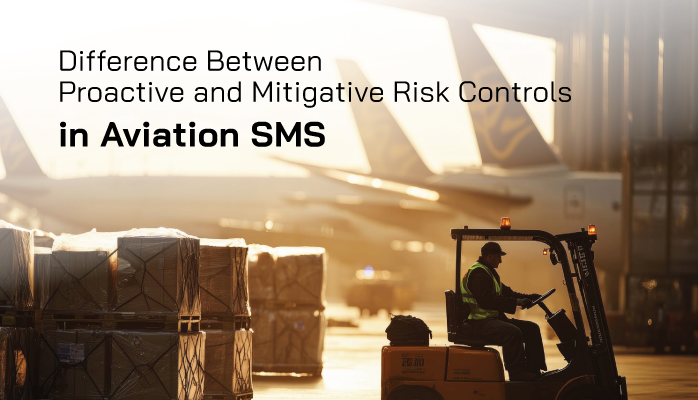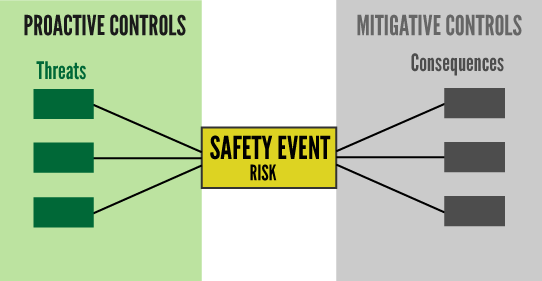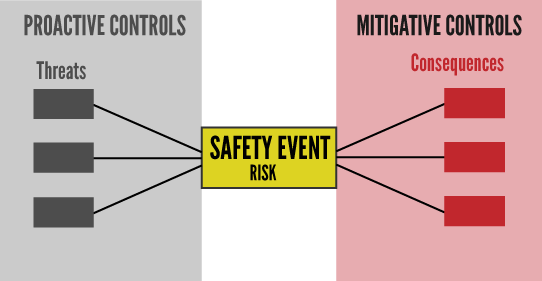What Is a Risk Control in Aviation SMS?

Hazard identification and risk management are two major activities of formal, aviation safety management systems (SMS). Once the hazard is identified, the safety concern is reported to management for treatment via the SMS risk management processes. SMS risk management processes evaluate:
- Affected system(s);
- Anticipated organizational risk from a risk analysis;
- Risk assessment to determine the priority of the safety concern; and
- Risk controls.
Simply put, risk control is a measure that an organization takes to either detect manifesting hazards, avoid risks, or lessen consequences resulting from an uncontrolled hazard.
Related Articles on Risk Controls in Aviation SMS
- What Is a Risk Control in Aviation SMS: Meaning, Purpose, Application
- Difference Between Hazards, Risks & Control Measures in Aviation SMS
- 5 Tips Reviewing Hazards, Risks & Controls in Aviation SMS - With Examples
A “measure” is simply anything management does with the goals of lessening/avoiding risk and consequences, such as:
- SMS training courses;
- Safety policy, procedures, and checklists;
- Equipment;
- Risk management tools;
- Checklist protocols;
- Daily operational duties/actions; and
- Physical objects (such as navigation signs, diagrams, etc.).
Risk Controls Are SMS Focal Point in Risk Management
Risk controls are the ultimate expression of risk management in aviation SMS implementations. Corrective actions and preventative actions, issue management, and safety data are all used with the end goal of implementing risk controls that:
- Are relevant to a specific safety need;
- Improve operational safety; and
- Can be monitored and updated.
As an aviation SMS becomes more mature, the organization will gradually improve the effectiveness and sophistication of risk controls. Employees and stakeholders in robust safety cultures continuously monitor the "systems" for anomalies and promptly submit safety reports as potential safety concerns are identified. Safety management teams react to the reported safety issues. One of the subsequent risk management activities is to review the affected systems and evaluate the effectiveness of implemented risk controls, which are also called "control measures" by many safety professionals.
Risk controls need to be monitored and periodically updated to meet changing safety needs and emerging risks. As we have seen, failing risk controls can be reported by stakeholders as they interact with the "system." Other environmental changes requiring action are identified by quality assurance departments through auditing, evaluations, and inspections. Through a process of continuous monitoring and improving risk controls, the aviation service provider becomes more efficient and safe.
When we talk about risk controls, we are generally talking about proactive risk controls and mitigative risk controls.
Related Articles on Risk Controls in Aviation SMS
- How to Implement Effective Control Measures
- How to Monitor the Effectiveness of Control Measures
- How to Evaluate and Justify a Risk Control in Aviation SMS
What Is a Proactive Risk Control

Proactive risk controls in aviation SMS implementations are used to avoid risks and prevent undesirable events from happening. Some common examples of proactive risk controls are:
- Hazard and risk fluency assessments;
- Hazard identification training;
- Security equipment;
- Bird scattering activities;
- Checklists and procedures;
- Daily inspections;
- Signs, lights, navigational objects;
- Aviation safety meetings; and
- Hazard reporting tools.
There are obviously countless more proactive risk controls, but the primary way to identify a proactive risk control is to determine whether or not the risk control is used to detect or avoid undesirable safety events. If so, then the risk control should be considered a proactive risk control.
Monitoring and implementing proactive risk controls are critically essential activities for all proactive risk management practitioners. This is one of the core activities of SMS. In fact, when the FAA was drafting SMS legislation, they stated the purpose of SMS implementations as:
The objective of Safety Management Systems (SMS) is to proactively manage safety, identify potential hazards, determine risk, and implement measures that mitigate the risk. The FAA envisions operators being able to use all of the components of SMS to enhance a carrier’s ability to identify safety issues and spot trends before they result in a near-miss, incident, or accident. For this reason, the FAA is requiring carriers to develop and implement an SMS.
Federal Register / Vol 80, No.5 (emphasis added).
Being able to implement proactive risk controls requires a detailed understanding of:
- The affected system(s);
- Hazards inherent within the affected systems;
- Credible, potential hazard-related consequences;
- Dynamics and root causes of hazard risks;
- Why hazards consequences may increase in severity in risk situations; and
- How to properly detect manifesting hazards, avoid threats, and/or negate the severity of them.
Related Articles on Monitoring Risk Controls in Aviation SMS
- FAA Part 5 - Monitor Safety Risk Controls in Aviation SMS
- FAA Part 5 Compliance | Safety Risk Management Risk Control Component
- How to Practice Reactive, Proactive, and Predictive Risk Management in Aviation SMS
What Are Primary Goals of Proactive Risk Controls?
The primary goals of proactive risk control center around pre-risk operations. Once a hazard has manifested itself, different types of controls are used to address potential hazard-related consequences.
Whereas mitigative controls often exist in the realm of being able to make decisions, proactive controls usually exist on a level of safety awareness. What this means is that proactive controls:
- Help employees be aware of safe conduct (procedures, wayfinding-signs, runway lights, etc.)
- Help people identify objects, behaviors, and situations that are threatening; and
- Aid people in the ability to efficiently ameliorate hazards before they cause a risk event.
We measure the effectiveness of proactive controls in two ways:
- Qualitatively: how well does the risk control clarify how to continue safe operations?
- Quantitatively: how often is this control associated with a risk event (i.e., how often does the risk control fail to fulfill its safety purpose)?
What Is a Mitigative Risk Control

Mitigative risk controls in aviation SMS are implemented with the purpose of:
- Deescalating a safety situation after suffering from hazard-related consequences;
- Returning operations to safety;
- Avoiding additional, potential damages and impacts; and
- Lessening unavoidable damages.
Some examples of mitigative risk controls are:
- Evasive maneuvers;
- Neurology of decision making training;
- Design standards of aircraft (such as being able to withstand damages);
- Post-risk procedures; and
- Runway monitoring technology.
There are as many mitigative as proactive risk controls, but the hallmark of any mitigative risk control is that it is put in place in order to help return to safe operations once safe operations are lost.
It would be easy to say that mitigative risk controls are not as “ideal” as proactive risk controls because mitigative controls arise from reactive risk management. However, this is a terrible misconception that exists in some safety cultures. Mitigative risk controls are as critical (if not more) to safe operations as proactive risk controls.
Being able to implement mitigative risk controls requires a details understanding of:
- Historical safety performance;
- The probable hazard-related consequences of risk events that go unchecked; and
- Best ways to respond to risk events in order to eliminate/reduce damages.
Related Aviation Risk Management Articles
- Difference Between Reactive, Predictive and Proactive Risk Management in Aviation SMS
- From Reactive to Proactive Risk Management in Aviation SMS
- 5 Indicators of Reactive or Proactive Safety Culture in Your Aviation SMS
What Are the Goals of Mitigative Risk Controls?
The primary goals of risk controls that mitigate are:
- Enhance decision making ability of employees;
- Help operations return to a point of safety; and
- Eliminate or reduce the severity of consequences.
Some risks can be eliminated completely with proper actions. Other risks, such as low-probability, and high-impact risks, can be very difficult to avoid and so require actions that attempt to lessen inevitable damages.
Mitigative risk controls absolutely require risk analysis and recurrent risk assessments on the risk. Uncertainties around the severity and likelihood of various damages will make a risk event all but impossible to eliminate or mitigate once it has occurred.
Mitigative risk controls correspond to aviation lagging indicators because they rely on historical performance. In other words, in actual operational environments, mitigative risk controls are almost always implemented in response to some kind of safety event.
Final Thoughts on Risk Controls in Aviation SMS
Risk controls have always been a "big deal" in aviation SMS; however, there has not been sufficient guidance on how to monitor risk controls. Furthermore, regulatory authorities have not been focusing too heavily on risk controls during their regular SMS audits. This will change.
An SMS implementation may require three to five years to fully implement. During the first years, SMS auditors are focused on the structure of a compliant SMS. Does the operator have all the "pieces" required for a compliant SMS implementation?
Once the SMS implementation is expected to be "mature," SMS auditors become more demanding. They want to see a demonstration of the SMS' performance and how risk controls are evaluated for effectiveness. In order to demonstrate whether a risk control is effective, you will need to analyze and measure its effectiveness on a regular basis. Evaluating risk controls in a spreadsheet is a non-starter, as the process is not efficient, nor is it sustainable for prolonged time periods.
Do you have a way to analyze control measures in your risk management process? If your SMS is in phase 3 or phase 4, then you should have a way to document risk controls. For an auditor, if there is no documentation, then it didn't happen. A best practice is to document risk controls in a centralized database and then review them whenever a new safety issue enters your risk management process.
If you don't have the tools to monitor and measure your risk controls, we can help.
Are you monitoring your risk controls? Can you select a risk control from your list of control measures and tell me how many times it has failed within the past year, two years, or five years?
If you are interested in improving your risk management activities, check out these short demo videos to learn how we can help. Since 2007, SMS Pro has been providing SMS data management tools to the aviation industry to specifically address the ICAO SMS mandate. SMS Pro is considered the best SMS database on the market. SMS Pro is not cheap, but it provides tremendous value to your SMS.
Last updated December 2025.







